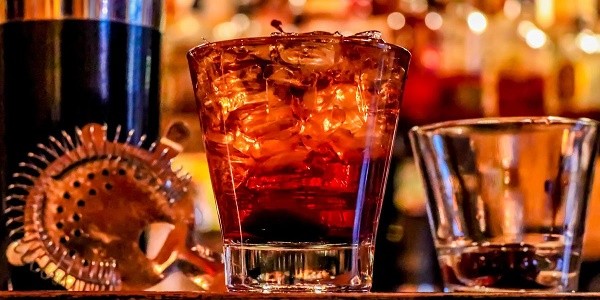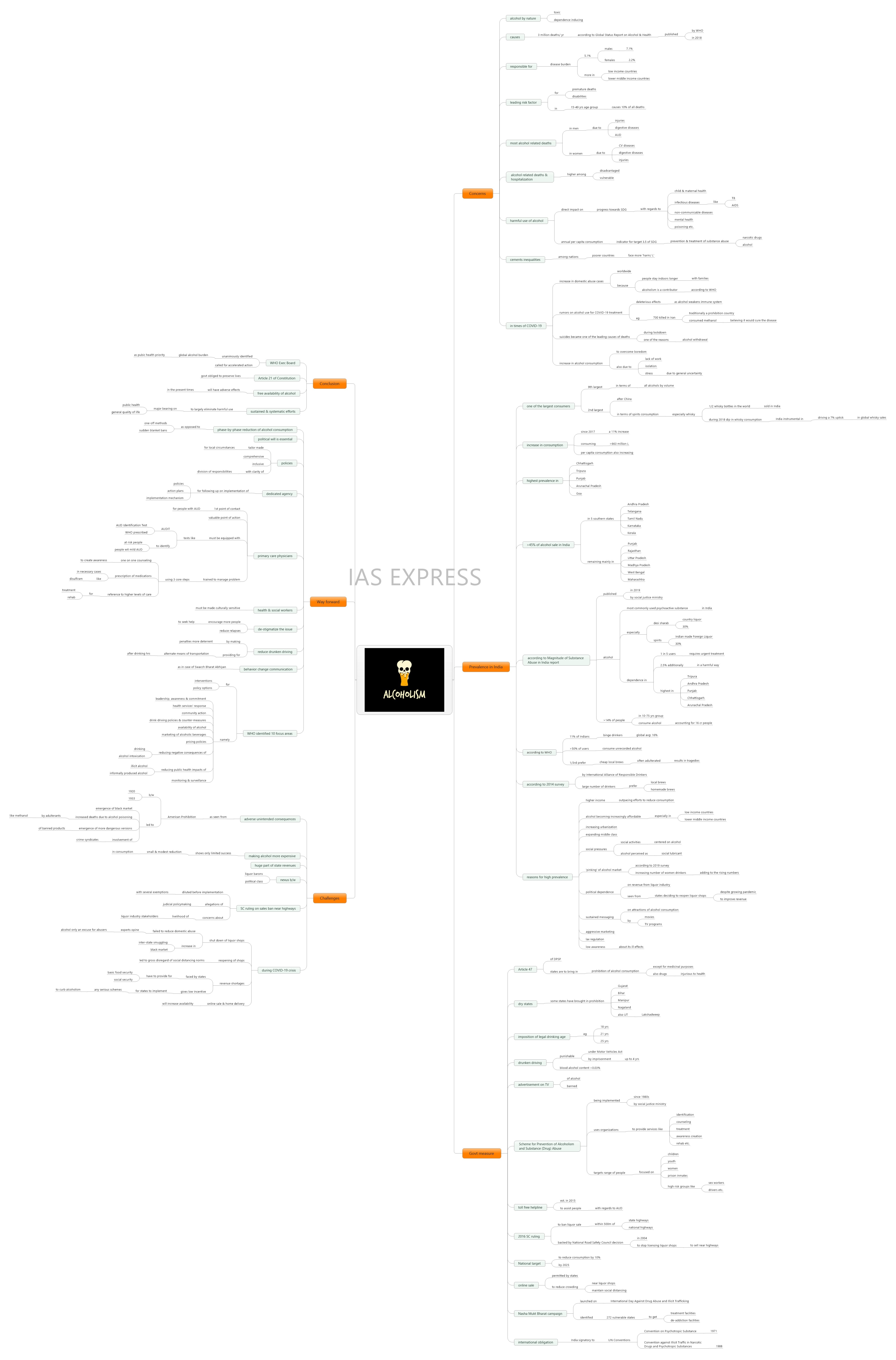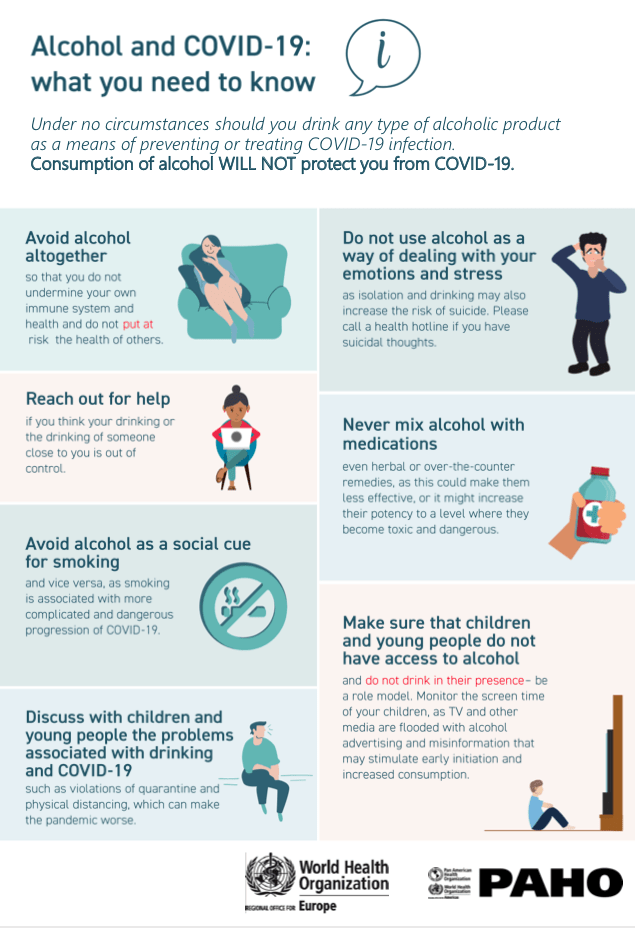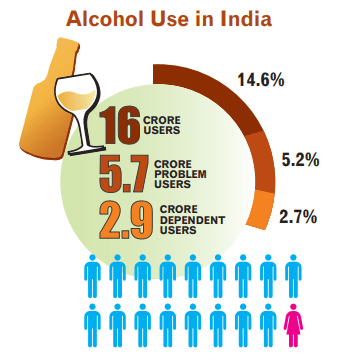Alcoholism in India- Concerns, Challenges and Way Forward

In March, India, like several countries shut down liquor shops. During this period, the mental health of many alcoholics deteriorated with several even attempting suicides. When the shops were reopened in May, long queues and chaotic crowds with blatant disregard for social distancing norms were observed across the country. States have started online sale of liquor. This calls for a look into the issue of alcoholism in India.
This topic of “Alcoholism in India- Concerns, Challenges and Way Forward” is important from the perspective of the UPSC IAS Examination, which falls under General Studies Portion.
Why is alcoholism a cause of concern?
- Alcohol, by its nature, is toxic and has ‘dependence inducing properties’.
- It causes about 3 million deaths across the world every year, according to Global Status Report on Alcohol and Health, 2018, released by WHO.
- Globally, it is responsible for 1% of disease burden. Alcohol is responsible for disease burden more among males (7.1%) than females (2.2%). This alcohol-attributable disease burden is especially high in low income and lower middle income countries.
- It is a leading risk factor for premature deaths and disabilities in the 15-49 years age group. 10% of all deaths in this age group can be attributed to alcohol consumption.
- Most of the alcohol related deaths among males were due to injuries, digestive diseases and alcohol use disorders (AUD). In case of females, it was mainly due to cardiovascular diseases, digestive diseases and injuries.
- Alcohol related hospitalization and deaths is higher among the vulnerable and disadvantaged
- The harmful use of alcohol has a direct impact on the countries’ progress towards Sustainable Development Goals– especially with regards to the health related targets like child and maternal health, infectious diseases like TB and AIDS, non-communicable diseases, mental health, poisoning, etc. Annual per capita consumption of alcohol is an indicator for target 3.5 of SDG i.e. “Strengthen the prevention and treatment of substance abuse, including narcotic drug abuse and harmful use of alcohol”.
- Alcoholism cements the inequalities between countries with the poorer countries facing higher ‘harm per litre’.
In times of COVID-19
- There has been a world-wide increase in domestic abuse cases with people staying indoors with their families for longer periods. WHO opines that alcohol can be a contributing factor.
- In the initial periods of the COVID-19 outbreak, rumours about alcohol killing off the virus led to deleterious effects. In fact, ethanol consumption is known to weaken the immune system.
- 700 people were killed in April in Iran when they consumed methanol believing that it might cure the disease. This is despite Iran being a prohibition country.
- During the initial stages of lockdown, suicides were one of the leading causes of death. Alcohol withdrawal was identified to be one of the reasons.
- People have been drinking more alcohol to overcome the boredom due to the lockdown.
How prevalent is alcoholism in India?
- India is one of the largest consumers of alcohol in the world. Of all alcohols, India is the 9th largest consumer by volume.
- After China, it is the largest consumer of spirits– especially of whisky. Almost one in every two bottles of whisky brought in the world is sold in India. During the 2018 global dip in alcohol consumption, India was instrumental in driving a 7% uptick in the global whisky sales.
- There has been an 11% increase in consumption since 2017– i.e. consuming over 663 million litres.
- The per capita consumption of alcohol is also increasing.
- Highest prevalence is in Chhattisgarh, Tripura, Punjab, Arunachal Pradesh and Goa.
- Over 45% of all the liquor sold in India is in just 5 southern states: Andhra Pradesh, Telangana, Tamil Nadu, Karnataka and Kerala. Notably, over 10% of these states’ revenues is from taxes on liquor sales.
- The next largest consumers in India are Punjab, Rajasthan, Uttar Pradesh, Madhya Pradesh, West Bengal and Maharashtra.
- According to the 2019 Magnitude of Substance Use in India report from the social justice ministry, alcohol is the most common psychoactive substance used by Indians.
- Over 14% of the 10-75 years age group consume alcohol. This means that 16 crore people consume alcohol.
- Predominantly consumed alcoholic beverages in India are ‘desi sharab’ (country liquor) and spirits (Indian made Foreign Liquor)– each accounting for 30%.
- AUD is prevalent in the states of Tripura, Andhra Pradesh, Punjab, Chhattisgarh and Arunachal Pradesh. An additional 5% of the population consume alcohol in a harmful way.
- The report highlighted that 1 in 5 alcohol users are affected by alcohol dependence and hence require urgent treatment.
- 11% of Indians are binge drinkers according to WHO. This is against a global average of 16%.
- A major cause of concern is that more than half of alcohol consumed in the country is ‘unrecorded alcohol’ according to WHO. 1/3rd of consumers drink cheap local brews– often adulterated and resulting in tragedies.
- A 2014 survey by International Alliance of Responsible Drinking found a preference for such local or homemade brews among a large number of drinkers.
Why does India have high levels of alcohol consumption?
- One of the reasons for the increase in alcohol consumption in India is that more people are earning sufficient income to purchase it. This has outpaced the efforts to reduce consumption.
- Alcohol is becoming increasingly affordable. This trend is also observed in low and middle income countries worldwide- more than in high income countries.
- Increased urbanisation and an expanding middle class are also contributors.
- Social pressures are a major contributor to the high prevalence of alcohol consumption in India. Many social activities are centred on alcohol and the drink being perceived as a ‘social lubricant’.
- A 2019 survey noted the increased consumption of alcohol among women– referred to as ‘the pinking’ of the alcohol market- as a contributor too.
- Political dependence on the revenue generated by the industry- especially among the states. This was evidenced by how states decided to reopen liquor shops despite a fast growing pandemic to improve their revenues.
- Sustained messaging about the ‘attractions of alcohol consumption’ via movies and other TV programs.
- Aggressive marketing by the alcohol industry.
- Lax regulation of the industry.
- Low awareness about the negative impacts of alcohol on health.
What are the measures taken by government to reduce alcoholism in India?
- The Constitution itself has provisions for bringing in alcohol prohibition in India. Article 47 of the Directive Principles of State Policy states that “the State shall endeavour to bring about prohibition of the consumption except for medicinal purposes of intoxicating drinks and of drugs which are injurious to health”
- Several states have imposed prohibition on alcohol. These states, dubbed ‘the dry states’, include Gujarat, Bihar, Manipur and Nagaland. Complete alcohol ban is also in force in the UT of Lakshadweep.
- States have imposed a legal drinking age in their jurisdiction. In some states it is 18 years, while in others it is 21 years and in yet others it is 25 years.
- Under the Motor Vehicles Act, any person found driving with a blood alcohol content of over 0.03% (drunken driving) is penalized. Punishment may even entail a prison term of up to 4 years.
- Advertisement of alcoholic beverages on television is banned in India.
- The Social Justice and Empowerment Ministry has been implementing the Scheme of Prevention of Alcoholism and Substance (Drug) Abuse since the 1980s. This scheme makes use of voluntary organizations (and others) to provide a range of services like identification, counselling, treatment, rehabilitation, creating awareness, etc. It targets a wide range of people with special focus on children, youth, women, prison inmates and other high risk groups like sex workers, drivers, etc.
- A toll-free helpline was set by the centre in 2015 to assist people with regards to substance dependence.
- In 2016, the Supreme Court banned the sale of liquor within 500 m of any national or state highway. In 2004, the National Road Safety Council too had agreed that liquor shops should not be licensed to open shop along national highways.
- The government has set a National Target to achieve a 10% reduction in prevalence of alcohol use by 2025.
- Several state governments have permitted the online sale of alcohol to reduce aggregation of crowds at the liquor shops.
- Recently, on International Day Against Drug Abuse and Illicit Trafficking, the centre launched the ‘Nasha Mukt Bharat’ campaign to curb alcoholism and drug abuse in India. 272 districts identified as ‘vulnerable’ are to get treatment and de-addiction facilities.
- India has an international obligation to curb alcoholism as it is signatory to the UN Conventions- Convention on Psychotropic Substances, 1971 and Convention against Illicit Traffic in Narcotic Drugs and Psychotropic Substances, 1988.
What are the challenges?
- Imposition of prohibition is known to have several adverse unintended consequences as seen from the American Prohibition experiment from 1920 to 1933. Its unintended consequences include the emergence of an entire black market for alcohol composed of speakeasies, bootleggers, organized crime syndicates, etc. which operated in every segment from production to distribution and sale. There was a significant increase in the number of deaths due to poisoning by methanol and other adulterants present in these illegally manufactured beverages.
- Strict regulations often have the unintended consequence of fuelling black market operations and consequently more dangerous versions of the banned product coming into the market.
- Several experiments with making alcohol more expensive only produced ‘small and modest’ reduction in its consumption.
- A huge part of state revenues is from sale of alcohol.
- There is a prevalence of nexus between the liquor barons and the political class.
- A day before the Supreme Court order regarding the ban of alcohol sales near highways, the rules were diluted to allow for several exemptions, after allegations of ‘judicial policymaking’ and several concerns raised about the livelihood of the alcohol industry’s stakeholders.
In times of COVID-19
- The closing down of liquor shops in the initial periods of lockdown failed to reduce domestic abuse cases. Experts opined that alcohol is simply an excuse used by abusers to act violently against family members. Now, they use the lack of alcohol as an excuse to abuse.
- There was an increase in alcohol smuggling across the state borders and emergence of black markets.
- The reopening of liquor shops led to gross disregard for social distancing norms among the alcohol consumers.
- The lockdown increased consumption of alcohol. This is perceived as a result of people trying to overcome boredom apart from lack of work, isolation and stress arising from general uncertainty.
- In the current times, revenue shortages are faced by the states with the lockdown restricting normal economic activities. At the same time, governments have to provide for the basic food and social security of the people. Hence, there is very low incentive for the government to bring in any serious schemes to curb alcoholism.
- The online sale and home delivery of alcohol, if it becomes the new norms, will increase the availability of alcohol. This would be detrimental to the efforts to restrict its availability over the years.
What is the way forward?
- Reducing alcoholism cannot be achieved using a one-off method or a sudden blanket ban across the country. It needs to be brought in by phases.
- Political will is a key component in reducing the harmful use of alcohol.
- The policies designed for the purpose must be tailor made for local circumstances. It should be comprehensive and inclusive with clarity in division of responsibilities.
- A dedicated agency can be established for following up on the implementation of these policies and the consequent action plans and implementation mechanisms.
- The primary care physicians are the first point of contact for those suffering from AUD. This presents a valuable route of action in AUD control. These physicians can be equipped with tests like the WHO prescribed AUDIT (AUD Identification Test) to identify at-risk people and those with milder levels of AUD.
- They can be trained to manage problems using 3 core steps:
- One-on-one counselling to create awareness about ill effects of alcohol.
- Prescription of medications (eg: disulfiram) in necessary cases.
- Referring patients to higher levels of care for treatment and rehabilitation.
- The health and social service providers for tackling AUDs must be made culturally sensitive. There is a need to de-stigmatize the issue to encourage more people to seek help and reduce relapses.
- The penalty for drunken driving must be appropriate enough to have a deterrent effect. Provision of alternate means of transport after the drinking hours can reduce alcohol-related accidents.
- The benefit of ‘behaviour change communication’ was seen with India’s Swachh Bharat Abhiyan. This could also be used for curbing problematic alcohol use.
- The WHO identified 10 key areas where the countries could focus on, with regards to interventions and policy options:
- Leadership, awareness and commitment
- Health services’ response
- Community action
- Drink-driving policies and countermeasures
- Availability of alcohol
- Marketing of alcoholic beverages
- Pricing policies
- Reducing the negative consequences of drinking and alcohol intoxication
- Reducing the public health impact of illicit alcohol and informally produced alcohol
- Monitoring and surveillance
Conclusion
As recent as in February, 2020, the WHO Executive Board unanimously identified global alcohol burden as a ‘public health priority’. It called for ‘accelerated action’ to curb alcohol harm. Article 21 of the Constitution puts an obligation on the government to preserve the life of the people. Continued free availability of alcohol will have an especially adverse effect in the present times. Sustained and systematic efforts to largely eliminate harmful alcohol use in the society will have a major bearing on public health and the general quality of life.
Practice question for mains
Several state governments have opted for online sale of alcohol in the midst of a pandemic. Compare the pros and cons of this decision. (250 words)
https://www.who.int/health-topics/alcohol#tab=tab_1
https://apps.who.int/iris/bitstream/handle/10665/274603/9789241565639-eng.pdf?ua=1
https://www.bbc.com/news/world-asia-india-52640266
http://socialjustice.nic.in/writereaddata/UploadFile/Magnitude_Substance_Use_India_REPORT.pdf
https://thewire.in/government/liquor-sale-alcohol-coronavirus
https://www.ncbi.nlm.nih.gov/pmc/articles/PMC7014857/
https://www.pbs.org/kenburns/prohibition/unintended-consequences/




